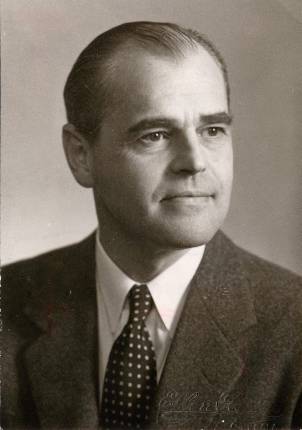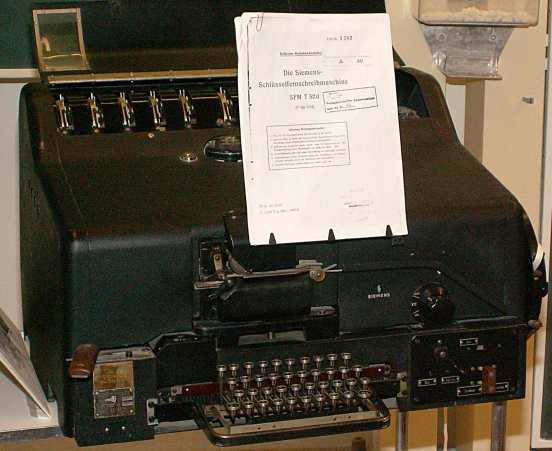Arne Beurling
Arne Beurling was a very prominent Swedish mathematician and cryptologist. He received his PhD from Uppsala University in 1933, and after a few years as an associate professor, he was a professor here from 1937 to 1954.
Beurling worked mainly on harmonic analysis, complex analysis and potential theory. He made several significant scientific contributions and is known, among other things, for Beurling's theorem on invariant subspaces, Beurling-Ahlfors' theorem on quasiconformal mappings and Beurling-Malliavin's theorem in function theory.
He became even more and widely known for his significant contributions to cryptography and in particular for his magnificent achievement in deciphering the G-writer, Germany's most advanced encryption machine during World War II. A much more difficult task than cracking the Enigma machine. Read more about the G-writer in the article below.
He left Uppsala in 1954 for an honorary professorship at the Institute for Advanced Study at Princeton University, where he later took over Albert Einstein's office. He remained at Princeton and in the same position until his retirement in 1973. He lived there with his family until his death in 1986.
Many have described him as a genius. He had a dimension to his thinking that was not logical but governed by intuition, emotion and aesthetics. For him, the world of mathematics seemed to be integrated with the real world and with life itself. He never built on what others had done but always approached new problems in his own way.
As a person, Arne Beurling was very charismatic and for his friends he had an unquestionable loyalty and boundless generosity. He was also known for his explosive temperament, which he inherited from his father, a sea captain, as well as his interest in the outdoors, adventure, hunting and sailing.
His doctoral thesis became one of the most influential mathematical publications of its time. However, it was delayed five years because his father took him on a hunting trip to South America to hunt alligators just before he finished. In the meantime the same results were published by another researcher, Lars Ahlfors from Finland, who later became Arne Beurling's best friend.
More about Arne Beurling
Arne Beurling was a fascinating person with an eventful life. Here are some suggestions for sources where you can learn more about him:
In English:
- About Arne Beurling on MacTutor, a website with biographies of famous mathematicians published by the School of Mathematics and Statistics, University of St Andrews, Scotland.
- The book "Codebreakers: Arne Beurling and the Swedish Crypto Program During World War II" by Bengt Beckman. Links to Amazone but can also be found elsewhere
- Jubilee publication (pdf) on Arne Beurling compiled in 2005 to mark the 100th anniversary of his birth. (mostly in English)
- Digital archive of Arne Beurling's mathematical manuscripts
In Swedish:
- Watch UR's (Swedish Educational Broadcasting Corporation) film on the history of Sweden and the G-writer, "The genius who cracked the secret G-writer". Only in Swedish.
- The documentary "G as in secret" on SVT open archive. Only in Swedish. Note that these are not real film clips of Arne Beurling in the film but staged with an actor (who does not significantly resemble Arne).
- The book "Kärlekens kod och krigets" by Lasse Eriksson and Kristina Östberg Eriksson. Only in Swedish. The English translation would be "The code of love and the code of war".

Picture of Arne Beurling from the 40s.
The G-writer
In addition to his professorship at Uppsala University, Arne Beurling worked for the Swedish Defence Cryptography Department (now FRA) during World War II. After the German invasion of Norway in spring 1940, German telegram traffic began to be sent via Swedish telegraph cables. The messages were encrypted with the so-called G-writer, der Geheimschreiber. The G-writer was Germany's most advanced encryption machine, more advanced than the Enigma machine and considered impossible to crack. Its ten wheels allowed almost a trillion different combinations.
In two weeks, using only pen and paper, Beurling managed to figure out how the G-writer's crypto worked. This incredible feat made it possible, in collaboration with others, to crack the entire crypto and construct a forcing device, 'app', which was used from autumn 1940 to continuously decode German telegram traffic. Thanks to Beurling, Sweden gained insight into German communications, which helped to keep Sweden out of the war.

A copy of the Model 52d G-printer deposited with the Department by the FRA and on display in the Explanatorium science exhibition at the Ångström Laboratory.
